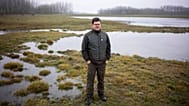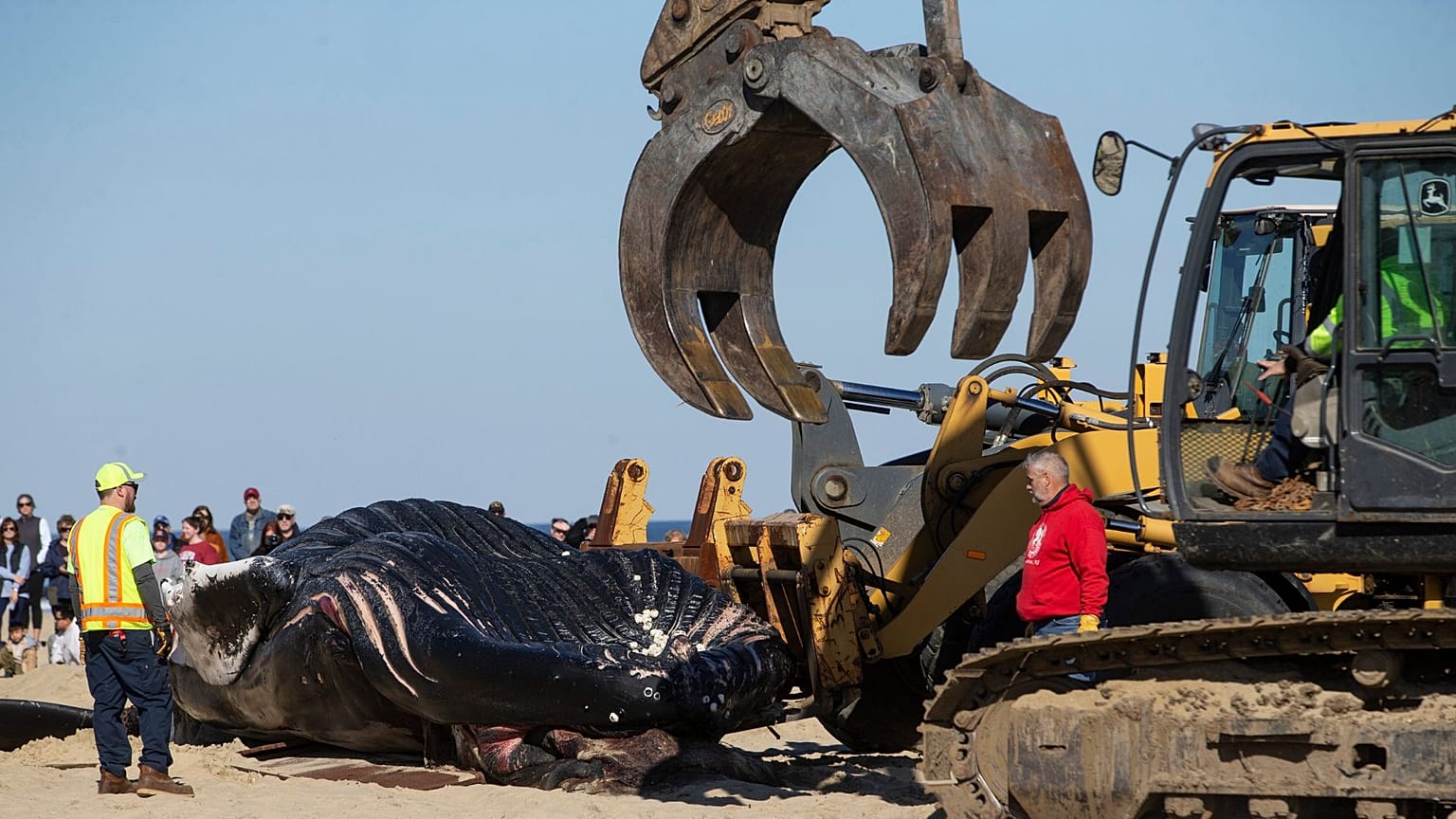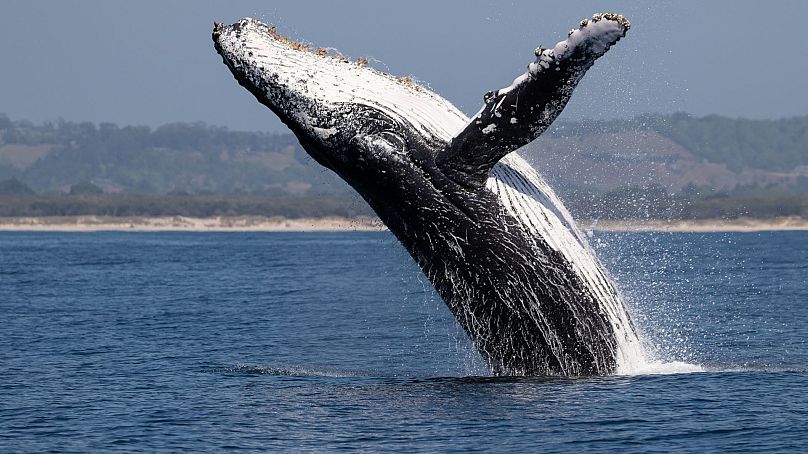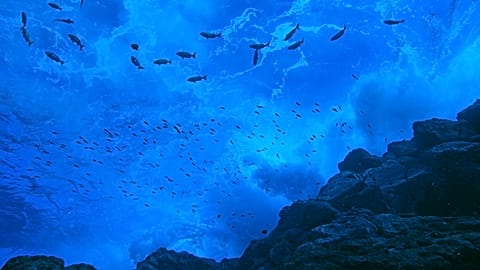Why do some conservationists, and Donald Trump, think that wind turbines are killing marine mammals?
Earlier this year, former US President Donald Trump used a rally to claim that wind turbines, or "windmills" as he called them, were causing whales to "wash up ashore" and go "batty". Is there any truth to the twice-impeached and reality TV host's claims?
At least 10 whales washed ashore in New York and New Jersey in early 2023. At the time, some protestors blamed wind farms.
“Save the whales - pause wind farms,” protestors at a thousand-strong rally urged in February.
But experts say it is very unlikely that offshore wind turbines are harming marine wildlife.
How many whales have washed up on America’s coastline?
An abnormally high number of humpback whales and North Atlantic right whales have died off of America’s northeast coastline this year.
The National Oceanic and Atmospheric Administration (NOAA) reports that 83 whales have died off the East Coast since 1 December 2022. Roughly half were humpbacks between Massachusetts and North Carolina, and two were critically-endangered right whales in North Carolina and Virginia.
The figure is particularly alarming given the diminishing size of local whale populations. There are less than 350 North Atlantic right whales remaining, for example.
Before 2016, whale stranding events off the Atlantic coast were rare. But in the last eight years, humpback whales have been dying at an advanced rate - one the federal government terms an “unusual mortality event”.
Are wind turbines to blame for whale deaths?
A coalition of environmentalists blamed wind turbines for the whale deaths.
But the trend predates major offshore wind farm construction that began after President Joe Biden’s election in 2020. His administration aims to power 10 million homes with offshore wind by 2030.
There are two wind farms in operation, with seven turbines total. Another two farms are being constructed off New York and Massachusetts.
South Fork Wind, located 56 kilometres east of Montauk Point, New York, began sending electricity from the first of its 12 turbines to the grid on 7 December. Vineyard Wind's 62-turbine wind farm 24 kilometres off Massachusetts is planned to open by early next year. Other large offshore wind projects are obtaining permits.
12 New Jersey mayors called for a moratorium on wind projects pending “further investigation” of the deaths.
Environmental organisation Clean Ocean Action blames turbine construction noise, which it insists can cause damage to a whale’s delicate inner ear.
"Why should offshore wind get a pass on scrutiny to ensure marine ecosystem protection, especially for endangered and protected species?" said executive director Cindy Zipf in a statement.
The focus on wind turbines has been picked up by some conservative media outlets in the US, appearing on Fox news.
Lawsuits from community groups delayed two large offshore wind projects in New Jersey planned by Danish wind energy developer Ørsted.
The company recently announced it is cancelling those projects, but that decision was based on their economic viability and had nothing to do with offshore wind opposition in New Jersey, says David Hardy, group executive vice president and CEO Americas at Ørsted.
NOAA Fisheries also insists that wind turbines are not to blame for the whale deaths.
“There is no evidence to support speculation that noise resulting from wind development-related site characterisation surveys could potentially cause mortality of whales, and no specific links between recent large whale mortalities and currently ongoing surveys,” it says.
In Europe, where offshore wind has been developed for more than three decades, national agencies also have not found causal links between wind farms and whale deaths.
What else could have caused the whale deaths?
Of the 178 humpback whale deaths investigated by scientists over the past four years, 40 per cent showed evidence of being killed by strikes with ships, or by entanglement with fishing gear. The others could not be linked to a specific cause.
It’s not just authorities who deny the link between wind turbines and whale deaths.
Greenpeace - who have advocated for whale protection for decades - have scorned the accusations as “baseless claims”.
“There has been a lot of talk about wind turbines and whale deaths, but there is no evidence whatsoever connecting the two. Meanwhile, the oceans face more threats now than at any time in history,” said Arlo Hemphill, Greenpeace USA’s project lead on deep sea mining,
“It’s just a cynical disinformation campaign” against offshore wind power, Greenpeace oceans director John Hocevar told USA today.
High stranding rates predate the construction of wind farms after Biden’s election.
In 2017, 78 whales died along the Atlantic coast of the US. 59 died per year in 2018, 2019 and 2020. 31 died in 2021, and 32 died in 2022.
Other areas with high numbers of wind farms have not seen an increase in whale mortality.
What real dangers do whales face?
Although claims about offshore wind causing whale deaths are unfounded, US scientists are collecting data to monitor any possible impacts short of fatality, such as altered behaviour or changes to migration routes.
This research is still in preliminary stages, says Doug Nowacek, a marine biologist at Duke University who helped put trackers on whales this summer off Massachusetts as part of a five-year federally-funded study.
While the exact causes of recent whale strandings along the East Coast mostly are not known, whales do face dangers from other human activities.
The biggest threats are shipping collisions and entanglement in fishing gear, according to scientists and federal authorities. Underwater noise pollution is another concern, they say.
One reason whale advocates push for renewable energy is that they say climate change is harming the animals - and less reliance on fossil fuels would help solve that problem.
Scientists say global warming has caused the right whale's preferred food - tiny crustaceans - to move as waters have warmed.
That means the whales have strayed from protected areas of ocean in search of food, leaving them vulnerable to ship strikes and entanglements. Large whales play a vitally important role in the ecosystem by storing carbon, so some scientists say they are also part of the solution to climate change.
Some advocates for protecting whales have characterised the push against offshore wind power as a distraction from real issues. “It seems that this is being used in an opportunistic way by anti-wind interests,” says Gib Brogan, fisheries campaign director at the environmental group Oceana.
The Heartland Institute, a conservative public policy group, has pushed back at offshore wind projects, with one director saying the wind projects are subject to unfairly lax regulatory restrictions compared to fossil fuel projects.
Smaller anti-wind groups have also organised in coastal communities to oppose projects they feel jeopardise water views, coastal industries and recreation.
What's being done to protect whales near wind farms?
Federal law sets limits on human-generated sound underwater for continuous noise and short sudden bursts.
Marine construction projects can reduce possible impact on marine mammals, including by pausing construction during migration seasons, using 'bubble curtains' to contain sound from pile-driving, and stationing trained observers with binoculars on ships to look for marine mammals.
Offshore wind developers are taking steps required by regulators, but also are voluntarily adopting measures to ensure marine mammals are not harmed. Ørsted won't drive piles between 1 December and 30 April, when whales are on the move. It uses additional lookout vehicles, encircles monopiles for turbines with bubble curtains and does underwater acoustic monitoring.
Equinor plans to use acoustic monitoring and infrared cameras to detect whales when it starts developing two lease areas off Long Island with its partner BP. The company says it will limit pile driving to months when right whales are least likely to be present.



















